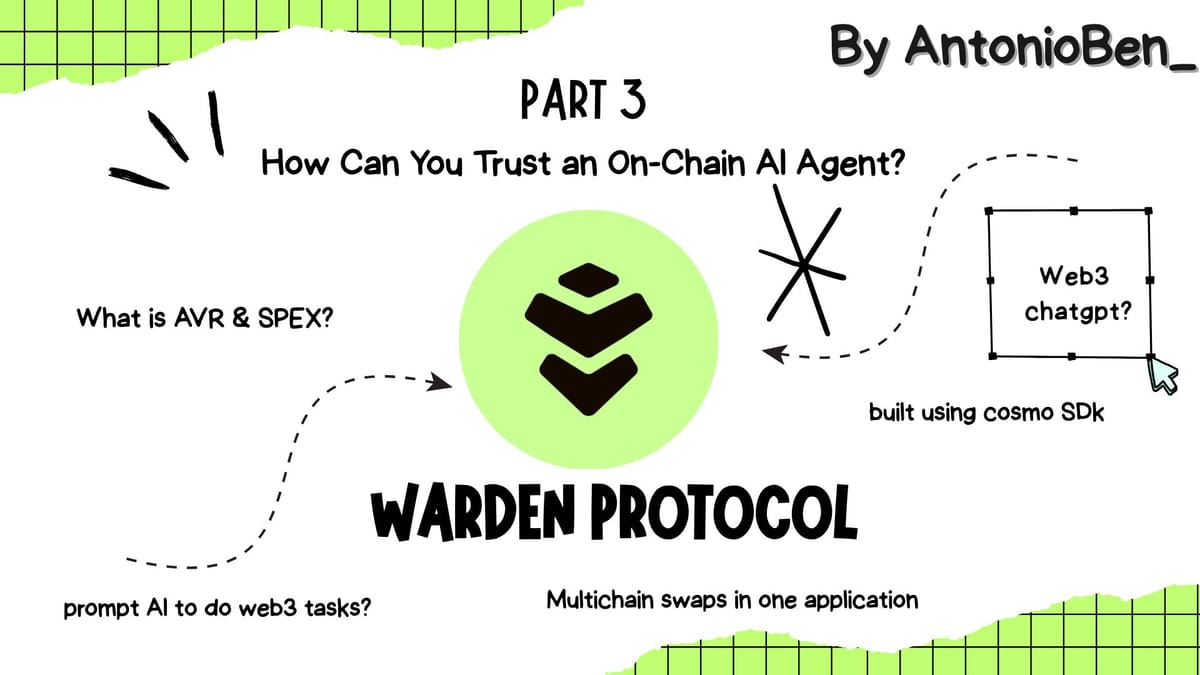Warden Protocol PT3: How Can You Trust an On-Chain AI Agent?

INTRODUCTION
~Blockchain was built for trust
~AI was built for autonomy
But what happens when you combine them?
Warden Protocol introduces a new model for programmable agents
Not just smart contracts
Not just signatures
But real reasoning agents that act across chains
But with that power comes a challenge:
How do you trust what these agents do?
This is where Warden’s Security and Trust Model steps in.
Powered by AVR and SPEX.
Let’s break it down.
The Problem: Agents Are Not Like Users
In traditional blockchains, trust is simple:
-A user signs a transaction
-The chain verifies the signature
-The transaction is confirmed
But agents are not regular users.
They do not wait for a person to click “approve.”
They think
They decide
They act
This introduces risk.
What if an agent misbehaves?
What if it goes beyond its permissions?
What if it uses fake data to justify its actions?
Warden needed a new system of trust.
The Solution: AVR and SPEX
Warden’s answer is a two-part model:
AVR (Agent Verification Runtime)
SPEX (Secure Programmable Execution)
Together, they make sure agents can operate freely
But always within verified and safe boundaries
Let us look at each one in plain terms
AVR: The Agent Judge
AVR acts like a courtroom for every agent
It reviews every decision the agent makes before it hits the blockchain
Here is what AVR does:
- Reads the action the agent is about to take
- Checks if it matches the permissions you set
- Validates whether the data source is trusted
- Confirms it does not exceed any spending or access limits
Only if all checks pass, the action is allowed
If anything fails, the action is blocked
This keeps your agent from doing anything it was not supposed to
Real life example:
Imagine giving someone a company card and telling them:
-You can only spend 100 dollars per day
-You can only book hotels from these sites
-You cannot book flights at all
Every time they try to use the card, the system checks:
Are they following the rules?
That is what AVR does.
It enforces the sandbox you defined
SPEX: The Secure Execution Box
SPEX is where your agent’s logic runs
It is a controlled environment that makes sure:
- The logic has not been changed
- The output matches the expected result
- The inputs are valid and untampered
SPEX ensures that what you launched is exactly what gets executed. No surprises, no hacks, no impersonation
It is like putting the agent in a transparent vault
You see exactly what it does
And you know it cannot cheat
Putting AVR and SPEX Together
Let us walk through an agent action step by step:
You create an agent that watches ETH prices and sells if it drops below a certain level
Agent: “Price dropped, I want to sell”
AVR: “Is this agent allowed to sell?” ✔️
AVR: “Is this price data from a trusted oracle?” ✔️
SPEX: “Let me run this logic in a secure space” ✔️
Execution: Action is confirmed on-chain
At every step, trust is enforced
Without needing to manually review every line of code
Why This Model Matters
Without AVR and SPEX, you would need to trust the developer who wrote the agent
Or you would have to inspect the logic every time
That does not scale
Warden’s model makes agent verification automatic
It gives you a trusted way to run intelligence
Without giving up safety
And this model applies across chains, across logic types, and across use cases
What Can You Control?
When you launch an agent, you get to define:
- Spending limits
- Approved plugins
- Data sources
- Chain access
- Specific conditions and boundaries
AVR and SPEX enforce this framework
It is not just smart
It is safe
Conclusion
Warden Protocol lets AI agents act with autonomy
But it also makes sure they do not act without permission
This balance is powered by:
AVR: The rules engine that verifies actions before they reach the chain
SPEX: The execution layer that makes sure logic runs securely and correctly
Together, they allow on-chain intelligence to operate without fear of abuse
You do not trust the agent
You trust the system that watches it
Saty tuned for PT 4

Comments ()